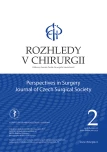-
Medical journals
- Career
Benign liver angiomyolipoma: a case study
Authors: J. Rosendorf 1,2; H. Mírka 3; M. Michal 4; R. Pálek 1,2; G. Šleisová 5; V. Třeška 1; V. Liška 1,2
Authors‘ workplace: Chirurgická klinika, Lékařská fakulta v Plzni, Univerzita Karlova, Fakultní nemocnice Plzeň 1; Biomedicínské centrum Lékařské fakulty v Plzni, Univerzita Karlova 2; Klinika zobrazovacích metod Lékařské fakulty v Plzni, Univerzita Karlova 3; Šiklův patologicko-anatomický ústav Lékařské fakulty v Plzni, Univerzita Karlova 4; Radiodiagnostické oddělení, Nemocnice Rokycany 5
Published in: Rozhl. Chir., 2020, roč. 99, č. 2, s. 91-94.
Category: Case Report
doi: https://doi.org/10.33699/PIS.2020.99.2.91–94Overview
Introduction: Hepatic angiomyolipoma is a rare mesenchymal tumor. It consists of vessels, fatty tissue and muscle tissue. These can appear in various ratios. While the kidney is the most common localization of angiomyolipoma, only about 300 cases have been described in the liver so far. It is a tumor of uncertain behavior. Most of the patients suffering from the lesion is asymptomatic. It is often preoperatively misdiagnosed using various imaging methods given its similarity to other hepatic tumors.
Case report: Our 64 years old female patient was being examined for dull abdominal pains with no other symptoms. Her close relatives suffered from no malignancies. Imaging exams showed a liver lesion highly suspicious for hepatocellular carcinoma. However, the patient showed no elevation of typical oncomarkers. We performed left lateral sectionectomy. A grey solid focal lesion was found in the resected tissue. Histological and immunohistochemical evaluation determined the diagnosis of angiomyolipoma. The postoperative period was uncomplicated. The patient has been followed at an office for hepato-pancreato-biliary diseases, with no signs of recurrence until the present.
Conclusion: Hepatic angiomyolipoma is a rare disease. The diagnostic process can be challenging as illustrated by the presented case. Even though the working diagnosis proved false, the chosen treatment was appropriate and delivered good results. Long-term postoperative follow-up is required.
Keywords:
angiomyolipoma – liver – liver surgery – liver tumors
Sources
-
Verver V, Janki S, Bramer WM, et al. Management of hepatic angiomyolipoma: A systematic review. Liver International 2017;37 : 1272–1280. doi:10.1111/liv.13381.
-
Garoufalia Z, Machairas N, Kostakis ID, et al. Malignant potential of epithelioid angiomyolipomas of the liver: A case report and comprehensive review of the literature. Mol Clin Oncol. 2018;9(2):226–230. doi: 10.3892/mco.2018.1659.
-
Klompenhouwer AJ, de Man RA, Thomeer MG, et al. Management of hepatic angiomyolipoma: A systematic review. Liver Int. 2017;37(9):1272−1280. doi:10.1111/liv.13381.
-
Ishak KG. Mesenchymal tumors of the liver. In: Okuda K, Peters RL, editors. Hepatocellular carcinoma. Wiley, New York 1976;247–307.
-
Tan Y, Xie X, Lin Y, et al. Hepatic epithelioid angiomyolipoma: clinical features and imaging findings of contrast-enhanced ultrasound and CT. Clin Radiol. 2017;72(4):339.e1−339.e6. doi:10.1016/j.crad.2016.10.018.
-
Jung DH, Hwang S, Hong SM, et al. Clinico-pathological correlation of hepatic angiomyolipoma: a series of 23 resection cases. ANZ J Surg. 2018;88(1−2):E60−E65. doi:10.1111/ans.13880.
-
Anysz-Grodzicka A, Pacho R, Grodzicki M, et al. Angiomyolipoma of the liver: analysis of typical features and pitfalls based on own experience and literature. Clin Imaging 2013;37(2):320−326. doi:10.1016/j.clinimag.2012.05.010.
-
Yang X, Li A, Wu M. Hepatic angiomyolipoma: clinical, imaging and pathological features in 178 cases. Med Oncol. 2013;30(1):416. doi:10.1007/s12032-012-0416-4.
-
Kuramoto K, Beppu T, Namimoto T, et al. Hepatic angiomyolipoma with special attention to radiologic imaging. Surg Case Rep. 2015;1(1):38. doi:10.1186/s40792-015-0038-0.
-
Costa S, Tente D, Costa A. Sporadic exophytic hepatic angiomyolipoma. BMJ Case Rep. 2012;10. pii: bcr2012007224. doi:10.1136/bcr-2012-007224.
-
Kim SH, Kang TW, Lim K, et al. A case of ruptured hepatic angiomyolipoma in a young male. Clin Mol Hepatol. 2017;23(2):179−183. doi:10.3350/cmh.2016.0027.
-
Liu J, Zhang CW, Hong DF, et al. Primary hepatic epithelioid angiomyolipoma: A malignant potential tumor which should be recognized. World J Gastroenterol. 2016;22(20):4908−4917. doi:10.3748/wjg.v22.i20.4908.
-
Liu W, Meng Z, Liu H, et al. Hepatic epithelioid angiomyolipoma is a rare and potentially severe but treatable tumor: A report of three cases and review of the literature. Oncol Lett. 2016;11(6):3669−3675.
-
Yan Z, Grenert JP, Joseph NM, et al. Hepatic angiomyolipoma: mutation analysis and immunohistochemical pitfalls in diagnosis. Histopathology 2018;73(1):101−108. doi:10.1111/his.13509.
-
Russell MC. Complications following hepatectomy. Surg Oncol Clin N Am. 2015;24(1):73−96. doi: 10.1016/j.soc.2014. 09.008.
Labels
Surgery Orthopaedics Trauma surgery
Article was published inPerspectives in Surgery

2020 Issue 2-
All articles in this issue
- Sagittal profile of cervical and whole spine before and after surgery of subaxial cervical spine
- Unintended durotomy during degenerative lumbar spine surgery in patients aged 60 years and older – incidence and risk factors
- Radiological analysis of the results of expandable implant insertion in one- to two-level cervical somatectomy
- Maisonneuve fracture
- Ankylosing spondylitis – specific aspects related to surgical treatment of cervical fracture – case report
- Benign liver angiomyolipoma: a case study
- Solitary fibrous tumor of the pleura as a rare cause of severe hypoglycemia: Doege-Potter syndrome
- Můžeme vyřešit současné problémy regionálních chirurgických pracovišť?
- Mezinárodní projekt ERASMUS+ − dovednosti perioperačních sester
- Perspectives in Surgery
- Journal archive
- Current issue
- Online only
- About the journal
Most read in this issue- Maisonneuve fracture
- Sagittal profile of cervical and whole spine before and after surgery of subaxial cervical spine
- Solitary fibrous tumor of the pleura as a rare cause of severe hypoglycemia: Doege-Potter syndrome
- Benign liver angiomyolipoma: a case study
Login#ADS_BOTTOM_SCRIPTS#Forgotten passwordEnter the email address that you registered with. We will send you instructions on how to set a new password.
- Career

